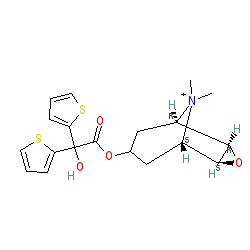GtoPdb is requesting financial support from commercial users. Please see our sustainability page for more information.
|
Synonyms: BA-679-BR | Spiriva®
tiotropium is an approved drug (FDA (2004))
Compound class:
Synthetic organic
Comment: We have chosen to display the structure of the parent compound, tiotropium, as this reflects the compound used in the experimental data listed under the 'biological activity' tab, and the links in the table above also represent the parent compound. However, the INN-assigned compound is in complex with bromide, the approved drug is also administered in this preparation. Note that the activity data in PubChem for this compound is split between the parent and the preparation with bromide.
Ligand Activity Visualisation ChartsThese are box plot that provide a unique visualisation, summarising all the activity data for a ligand taken from ChEMBL and GtoPdb across multiple targets and species. Click on a plot to see the median, interquartile range, low and high data points. A value of zero indicates that no data are available. A separate chart is created for each target, and where possible the algorithm tries to merge ChEMBL and GtoPdb targets by matching them on name and UniProt accession, for each available species. However, please note that inconsistency in naming of targets may lead to data for the same target being reported across multiple charts. ✖
View more information in the IUPHAR Pharmacology Education Project: tiotropium |
|
|||||||||||||||||||||||||||||||||||
| References |
|
1. Disse B, Reichl R, Speck G, Traunecker W, Ludwig Rominger KL, Hammer R. (1993)
Ba 679 BR, a novel long-acting anticholinergic bronchodilator. Life Sci, 52 (5-6): 537-44. [PMID:8441333] |
|
2. Dowling MR, Charlton SJ. (2006)
Quantifying the association and dissociation rates of unlabelled antagonists at the muscarinic M3 receptor. Br J Pharmacol, 148 (7): 927-37. [PMID:16847442] |
|
3. Prat M, Fernández D, Buil MA, Crespo MI, Casals G, Ferrer M, Tort L, Castro J, Monleón JM, Gavaldà A et al.. (2009)
Discovery of novel quaternary ammonium derivatives of (3R)-quinuclidinol esters as potent and long-acting muscarinic antagonists with potential for minimal systemic exposure after inhaled administration: identification of (3R)-3-{[hydroxy(di-2-thienyl)acetyl]oxy}-1-(3-phenoxypropyl)-1-azoniabicyclo[2.2.2]octane bromide (aclidinium bromide). J Med Chem, 52 (16): 5076-92. [PMID:19653626] |
|
4. Sykes DA, Dowling MR, Leighton-Davies J, Kent TC, Fawcett L, Renard E, Trifilieff A, Charlton SJ. (2012)
The Influence of receptor kinetics on the onset and duration of action and the therapeutic index of NVA237 and tiotropium. J Pharmacol Exp Ther, 343 (2): 520-8. [PMID:22854200] |
|
5. Tanis SP, Plewe MB, Johnson TW, Butler SL, Dalvie D, DeLisle D, Dress KR, Hu Q, Huang B, Kuehler JE et al.. (2010)
Azaindole N-methyl hydroxamic acids as HIV-1 integrase inhibitors-II. The impact of physicochemical properties on ADME and PK. Bioorg Med Chem Lett, 20 (24): 7429-34. [PMID:21036042] |









